
PERU INFO
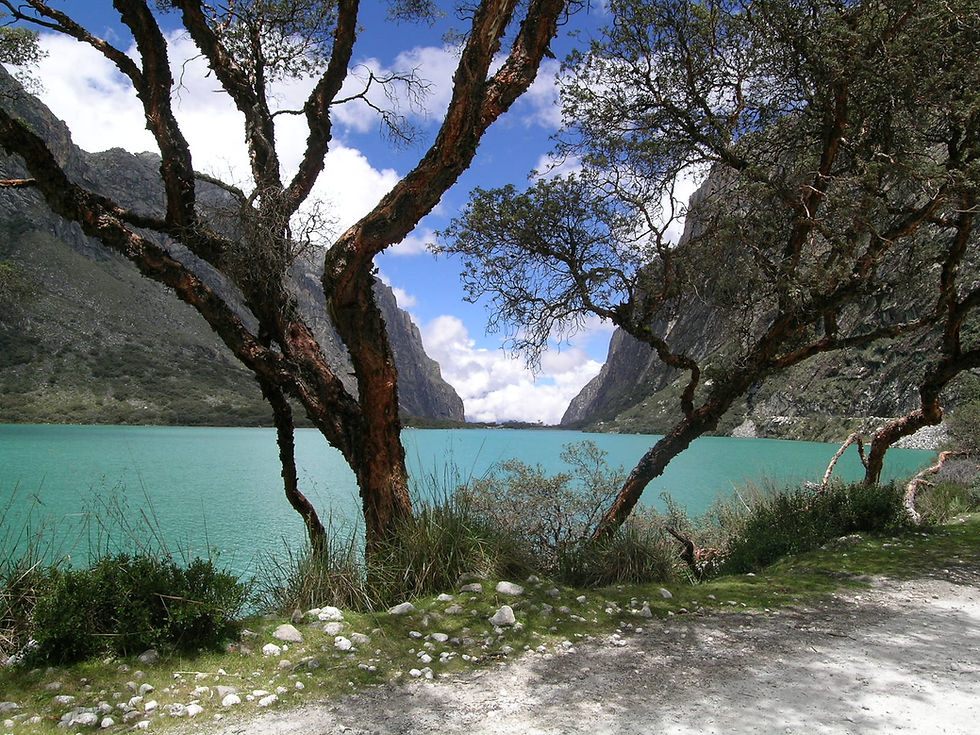
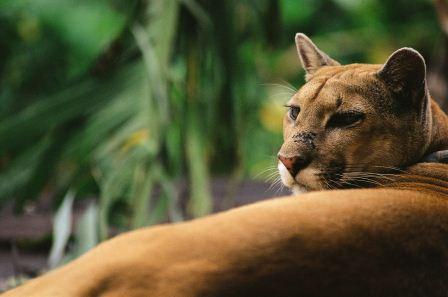


Home > Tourism > A different Peru > Hidden treasures
Discover Peru
The hidden treasures of Peru
Cuzco region
Tipón
Admission with Boleto Turístico
5 km (16 mi) from Cusco (30 mn), this impressive complex of terraces has probably been used as a laboratory for the development of agricultural products by the Incas.
Its ingenious system of irrigation and hydraulic technology with canals sometimes underground earned him the title of Civil Engineering Marvel by the American Society of Civil Engineers of the United States.
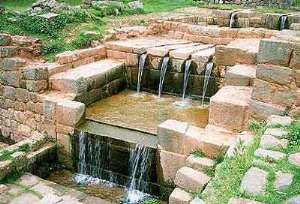
Trujillo region
566 km (352 mi) north Lima (8 hours by highway) on the coast.
Chan Chan
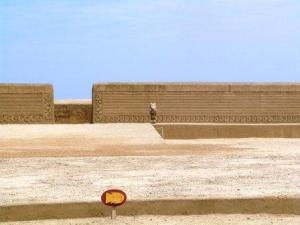
10 minutes northwest of Trujillo, this huge site was the capital of the Chimu Empire and was declared a World Heritage Site by UNESCO in 1986. The impressive Chan Chan is the largest adobe city in the world, covering 20 km2 (0.4 sq mi) and archaeologists estimate its population to 100,000 inhabitants until the arrival of the Incas in the 15th century. The city has ten districts surrounded by walls that reach up to 10 meters (33 ft) high, finely engraved with geometric patterns or representing mythological figures and animals. A maze of streets links the different plazas, palaces and urban areas.
Huaca de la Luna
15 minutes south of Trujillo, these two archaeological sites belong to the Mochica civilization. The Temple of the Sun was a political and administrative center composed of five levels built with 130 million adobe bricks (mud bricks). The Temple of the Moon was a ceremonial center and consists of several temples built, each covering the the olders. Admire the impressive frescoes that adorn the walls, geometric figures and representations of the Mochica god Ai-apaec.
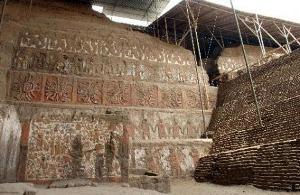
Chiclayo region
780 km (485 mi) north Lima (12 hours by highway) and 214 km (133 mi) north Trujillo (3 h), on the coast.
Señor de Sipán
In 1987, the Peruvian archaeologist Walter Alva held the excavation of a tomb in the village of Sipan 27 km (17 mi) east of Chiclayo, at a place called Huaca Rajada, a complex consisting of two pyramids joined by a platform.
Research continues today and 15 royal tombs in total were found. A museum located in the site exhibits many archaeological pieces.
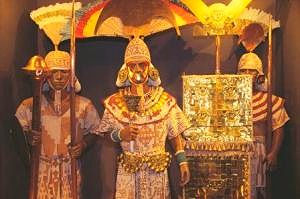
The tomb of the Lord of Sipan is considered the most important of America and is often compared to that of Tutankhamun in Egypt for the riches it contains.
The Lord of Sipan was a leader of the Mochica civilization and was buried in 250 AD with 8 other people, 2 llamas, one dog, numerous ceramics and more than 400 items of gold, silver, copper and semi-precious stones.
Museo Tumbas Reales
Av. Juan Pablo Vizcardo y Guzmán 895 – Lambayeque – Open Tue/Sun from 9:00 am to 5:00 pm.
This amazing museum, specially built in 2002 to show the fabulous treasures of Sipan, exhibits more than 3,000 ceramics, 2,000 archaeological pieces in precious metal and the representation of the tombs.
Cajamarca region
872 km (542 mi) north Lima (16 h) and 306 km (190 mi) east Trujillo (7 h by highway) – 2,700 m (8,856 ft) above sea level
Baños del Inca
6 km (4 mi) east Cajamarca - Open 7 days a week from 6:00 am to 6:00 pm
This baths complex, Inti Puquio in Quechua (Fountains of the Sun), is considered the spa of America. The healing properties of its sources (Perolitos) are recognized to treat rheumatism, skin problems, bone diseases and the nervous system.
It is the main attraction of the region, numerous pools have been built during the reign of the Great Inca Pachacutec and all Inca emperors came here to enjoy them. Inca Atahualpa was here with his army to the arrival of Pizarro.
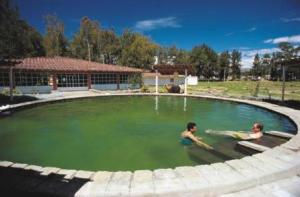
Enjoying the benefits of its volcanic waters you can imagine for a moment being in the place of the Inca relaxing before a battle. Today the complex is more extensive and you can take advantage of saunas and natural herbal treatments.
Chachapoyas region
1,200 km (746 mi) north Lima (21 h by highway).
Gocta cataract
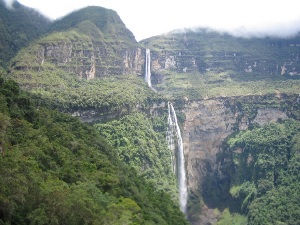
Kuélap
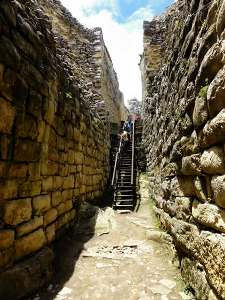
1 hour north of Chachapoyas is the village of Cocachimba and then a 3 hour hike through lush vegetation, appears a mountain where 22 stunning waterfalls emerge. Gocta is the third tallest waterfall in the world with 771 meters (2,529 ft) after Salto de Angel (972 m / 3,188 ft) in Venezuela and Tugelafalls (948 m / 3,109 ft) in South Africa.
2 hours south of Chachapoyas, is the amazing Fortress of Kuelap situated on a ridge at an altitude of 3,000 m (9,840 ft). This fortified city of Chachapoyas civilization dates from about 1000 AD. It consists of several platforms with over 400 constructions, most of them cylindrical and the site is surrounded by a massive wall of almost 20 meters (66 ft) high.
The most impressive are its access to ascend to the first platform, corridors flanked by high walls of more than 30 meters (100 ft). This narrows sharply as it rises, culminating in a space large enough for one person to enter.
A third access more like an exit to ... the void!
Leymebamba
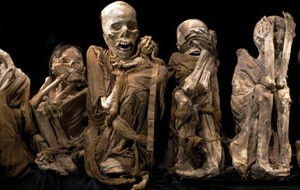
In this village 82 km / 51 mi (2 hours) south of Chachapoyas towards Cajamarca, is the best museum in the region. The Museo Centro Mallqui (open Tuesday to Sunday from 9:30 am to 2:30 pm), shows numerous archaeological pieces and especially the 219 mummies found in perfect condition near Lake of the Condors located 10 hours riding.
Central Andes
The city of Huaraz is located 410 km (256 mi) north Lima (8 h by highway and 1 h by airplane).
Huascarán National Park
This park is located in the Cordillera Blanca with 160 km (100 mi) long and an area of 340,000 hectares (1,300 sq mi), declared by UNESCO as Reserve of Biosphere Core in 1977 and Natural Heritage of Humanity in 1985 for the richness of its flora and fauna as well as the beauty of its landscapes. The park contain 663 glaciers, 296 lakes and endemic plant and animal species such as the Puya Raimondi, a species of cactus in the same family as the pineapple that produces 8,000 flowers just before he died and the Oso de Anteojos (spectacled bear).
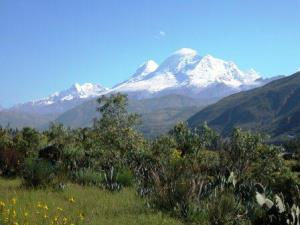
Llanganuco
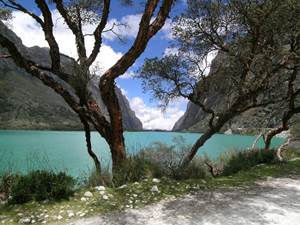
This stunning natural site in the middle of the mountains at 3,850 m (12,628 ft) above sea level at the foot of Huascaran is composed of two lagoons with turquoise water, Warmicocha and Orkoncocha.
Chavín de Huántar
This complex was the capital of the Chavin culture and was built in 850 BC. Located in the Callejón de Conchucos 4 hours east of Huaraz, at 3,177 m (10,421 ft) asl, it is the most important archaeological site in the central Andes.
Chavin de Huantar is composed of a U-shaped plaza with a sunken circular court in the center, several pyramids built of stone and crossed by an extensive network of maze of tunnels with a sophisticated ventilation system that inspired the construction of the tunnels of the rescue operation during the Japanese embassy hostage crisis in 1996.
These galleries lead to several rooms, one of them in the Templo Viejo (Old Temple) contain a sculpture of the Lanzón or Smiling God in charge of the soil fertility and the seasons, a monolith of nearly 5 metros (16 ft) tall engraved with mythological drawings, depicts a human-feline hybrid.
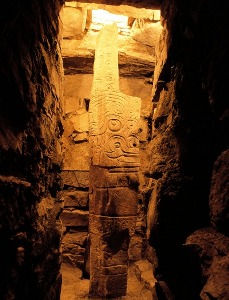
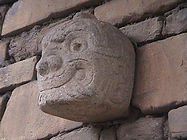
Inside the Templo Nuevo (New Temple) also called Castillo (Castle) for its impressive size, the galleries are the most important and its purpose is still a mystery.
Cabezas clavas (carved stone heads) also combining human and feline traits, protude from the temples walls.
Ferrocarril Central Andino
The Ferrocarril Central Andino connects Lima to Huancayo.
The trip of 346 km (215 mi) is made in 12 hours by one of the most impressive travel in the world, through 69 tunnels, 58 bridges and passing Ticlio, a mountain pass reaching 4,782 m (15,685 ft) above sea level.
It was the highest railway in the world until the construction in 2007 of the Qing Zang line in Tibet that reach to 5,068 meters (16,623 ft) asl.
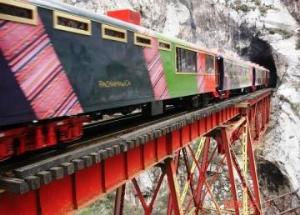
From Huancayo, you can reach the city of Huancavelica by a more popular train called the "Tren Macho"... Because "departs when he want and arrives when he can" by the whims of its old locomotive.
Recently renovated, now seems to be more punctual. The trip of 128 km (80 mi) in 4 h 30 is every day and the scenery is beautiful.
Amazon rainforest
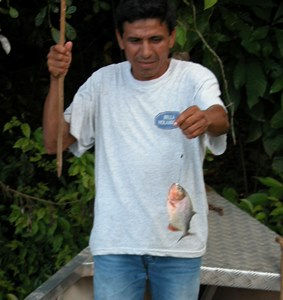
The world's largest and most diverse jungle is a paradise for nature lovers. Here it seems another world, impressive and fascinating where everything is gigantic, an explosion of colors, smells, and unknown sounds, well, we're on another planet.
Venturing into the jungle, we enter another dimension, giant trees can reach 40 meters (130 ft) in height and 3 meters (10 ft) in diameter, flowers and leaves are immense, the cacophony is permanent, the Amazonia never sleeps.
Allpahuayo-Mishana National Reserve
Only 20 km southwest of Iquitos starts this small reserve, impressive for its diversity and its World Records as the largest number of species of trees per hectare (300), the largest variety of reptiles (140), amphibians (112), primates (17) and birds (600) within a locality.
The park also has nearly 2,000 species of plants including a hundred endemic to Peru, a dozen vertebrates species and 28 endangered species such as the giant otter, the harpy eagle, the tocón negro, the monkey guapo rojo and the giant armadillo.
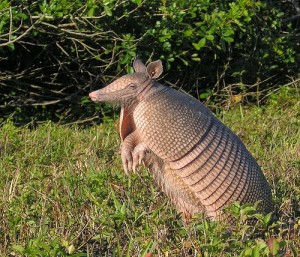
Manú National Park
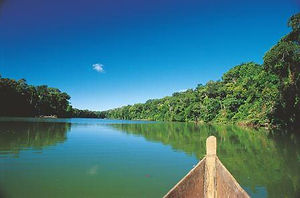
Also called Manu Biosphere Reserve, this huge park located northeast of Cusco was declared a World Heritage Site by UNESCO in 1978. It extends from the Amazon jungle at 300 m (1 ft) to the Andes at 3,800 m (12,500 ft) a.s.l. Manu is one of the places in the world where you will find the largest variety of plants and animals. Manú has the highest levels of biodiversity of any park in the world with more than 20,000 species of plants, 1,000 species of bird, 1,200 of butterflies, 200 of mammals and 14 of monkeys includes the Pygmy marmoset the smallest monkey in the world with a weight of 100 g (3.5 oz).
The reserve not only protects the fauna and flora, but also the cultural aspect of peoples as Matsiguenkas, Amahuacas, Ynes, Amarakaeris, Huashipaires and Nahuas to their languages, folklore, lifestyles and natural medicine, many of these Indians have no contact with the modern world.
Tourism












